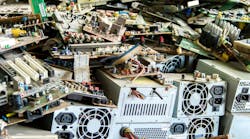We Only Know What Happens to a Fifth of the World's Electronic Waste
The amount of electronic waste – refrigerators, televisions, computers, smartphones, and other devices thrown out or recycled – produced worldwide increased to 49.3 million tons over the last year, up from 46.1 million tons in 2014, according to a new report from the United Nations.
But only around a fifth of that digital debris was collected and the precious metals inside recovered through formal recycling programs, even though that percentage increased from 15.5% in 2014. The rest falls through cracks in the rules and regulations meant to stem – and document – the flow of harmful e-waste across the globe.
The fate of around 76% of the world’s e-waste is unknown, according to The Global E-Waste Monitor. The report is the result of a partnership between the U.N., the International Telecommunications Union and the International Solid Waste Association on charting global levels of e-waste, which the report classifies as anything with a battery or cord.
The e-waste unaccounted for could be shipped out to other countries, where it collects in vast junkyards like Agbogbloshie, Ghana, and Guiyu, China, an infamous dumping ground where conditions have allegedly improved after an international outcry. The workers in these cities pour acid over electronics to extract precious metals like gold, cook circuit boards to liberate chips, and melt plastic packaging, causing severe health risks and environmental harm.
The largely self-employed recyclers compete to wring out the gold, silver, copper, platinum, palladium, and other valuable materials used in devices. The United Nations estimated that all the raw materials left inside e-waste would have been worth around $55 billion had they been recovered, or around $1,100 for every ton of e-waste.
The last 4% of e-waste is thrown out in higher-income countries with the trash, which will be incinerated or buried in landfills, allowing toxins to leech into the air, water and ground. That percentage is up from around 1.7% of all e-waste in 2014.
The problem of electronic waste is not going away any time soon, the report said. More of the world's population is connecting to the internet. As incomes grow worldwide, people have money to more regularly swap out devices with faster processors and new features. The report predicts that 57.5 million tons of used electronics will be thrown out globally in 2021.
Furthermore, companies have been less than enthusiastic about giving customers the right to repair broken electronics. While Apple has been praised for flushing out conflict minerals from its supply chain, it has faced criticism for making its phones and other products extremely hard to fix, unlike Dell and Hewlett Packard, which go so far as selling replacement parts.
The shadowy fate of e-waste is particularly evident in the United States, which has not passed federal rules regulating the recycling of personal computers and other devices, even though it goes through so many of them. Last year, it generated 6.95 million tons of e-waste, but the United Nations report estimates that only 1.5 million tons were collected.
“The whereabouts of the remainder of the e-waste is largely unknown in the U.S., which reflects a larger lack of data about the global flow of e-waste,” the report said. It is legal to export almost all electronic waste in the United States to developing countries because of federal exemptions to laws that classify circuit boards and other electronics as hazardous waste.
The United Nations report is not all negative, though. Today, two-thirds of the world’s population is covered by e-waste management laws, up from 44% of the global population in 2014. Importantly, India, the world’s fifth largest producer of electronic waste, passed new rules last year for recycling the analog and digital detritus.
On the other hand, there is insufficient data to track the amount of used electronics shipped from richer to poor countries, the report said. In addition, the report cautioned that countries that have enacted national electronic waste laws do not always enforce them, and many lack the resources required to collect data or set realistic recycling targets.
“We live in a time of transition to a more digital world, where automation, sensors and artificial intelligence are transforming industry and society,” said Antonis Mavropoulos, president of the International Solid Waste Association, in a statement. “E-waste is the most emblematic by-product of this transition."

